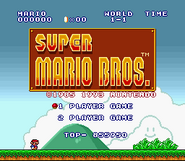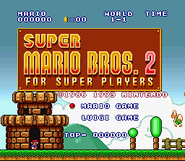Synopsis[]
The All-Star Magic of Mario Continues! Revisit the magic and fun of the classic Super Mario Bros. series on your Super NES! All the great Super Mario Bros. games for the NES have been powered up with 16-bit graphics and sound and collected on one super game pak. As an added bonus, the previously unreleased "Lost Levels" are included. These super challenging courses have never been available in this country until now!
In Other Languages[]
| Language | Title |
|---|---|
| Japanese | スーパーマリオコレクション |
| Korean | 슈퍼 마리오 올스타즈 |
Release timeline[]
| Console | Country of origin | Date |
|---|---|---|
| Super NES | Japan | July 14, 1993[1] |
| Super NES | USA | August 1993 |
| Super NES | UK | December 16, 1993 |
| Super NES | South Korea | 1994 |
| Super NES (re-release) | USA | November 4, 1998 |
| Wii | Japan | October 21, 2010 |
| Wii | UK | December 3, 2010 |
| Wii | USA | December 12, 2010 |
In the 1994 re-release with Super Mario World, Luigi's sprite is different, as he is no longer a green Mario.
Commercial advertisements[]
- During the November 11, 1993 broadcast of The Wizard of Oz on CBS, there was a commercial about a "$25 million Instant Win Game" contest, courtesy of Domino's Pizza. Super Mario All-Stars was involved with this commercial.
Music[]
- Title Screen
- Game Select Screen
Super Mario Bros. 1 & The Lost Levels[]
- Title Screen (SMB1)
- Title Screen (SMB2J)
- Overworld
- Course Clear
- Underground
- Castle
- King Bowser
- Underwater
- Final Bowser
- World Clear
- Ending
- Bonus Area
- Starman
- Death
- Game Over
Super Mario Bros. 2[]
- Title Screen
- Player Select
- Overworld
- Underground
- Fanfare
- Birdo
- Course Clear
- Wart
- Ending
- Death
- Game Over
Super Mario Bros. 3[]
- Title Screen
- World 1 Map Screen
- World 2 Map Screen
- World 3 Map Screen
- World 4 Map Screen
- World 5 Map Screen
- World 6 Map Screen
- World 7 Map Screen
- World 8 Map Screen
- Warp Zone
- Music Box
- Overworld
- Overworld 2
- In the Clouds
- Underwater
- Course Clear
- Hammer Bros. Battle
- Fortress
- King's Chamber
- Airship
- Boss Battle
- World Clear
- Princess's Letter
- Bowser
- Ending
- Toad's House
- Bonus Game
- Bonus Win
- Death
- Game Over
Regional differences[]
Of the following facts, these show what is different in the Japanese version of Super Mario All-Stars:
- There is a different crowd chatter, comparing to the two versions.
- On the title screen, instead of the lights revealing after pressing Start, the screen will automatically fade out.
- Three of the box arts are completely different in the Japanese version. In the U.S. version, the "Lost Levels" box is given English text.
- The "Select Game" screens also have a couple different colors.
- The Super Mario Bros. Lost Levels title screen has the words "Super Mario Bros. 2 for Super Players" in its logo.
- Even Super Mario Bros. 2's title screen is different. You will see words "Super Mario USA", along with three copyright years.
Version differences[]
Many differences, including a couple of glitch fixes, occurred between the original NES versions of the four Super Mario games and their Super NES counterparts in Super Mario All-Stars.
- All four title screens now have background music, and one of the Player Modes will disappear after opening an old file.
- Luigi is taller than Mario in every game.
Super Mario Bros. (1 and Lost Levels)[]
- The number of lives is now always a counting number rather than a crown and a symbol from the CHR table.
- Players will immediately take turns after completing each level in addition to also losing a life.
- Mario can jump above the blocks he just broke with his head.
- The bonus rooms and coin heavens use completely different music.
- When you face Bowser, the music changes to a more epic theme for any typical boss battle. There is a different epic theme also available when facing the last Bowser.
- The Minus World glitch still works, but the pipes will only lead to Worlds 2, 3 and 4. Therefore, the Minus World is partially removed.
- A form of small and fiery Mario at the same time is not possible.
- Audio cues are given for key points in the maze levels (Worlds 4-4, 7-4 and 8-4) if you chose the correct path or the wrong path.
- In each world, a different number of Toads escape from their tied bags. Each number of Toads from the bag would usually match the world number.
These facts were posted to TMK on July 24, 2008.
Super Mario Bros. 2[]
- You can choose a different character after you lose a life.
- After entering a warp vase, you will see the screen look a little wavy, and hear weird music.
- You will not see Birdo holding anything while fighting her.
- Some of the levels reverse the sky backgrounds, from nighttime to daytime, or daytime to nighttime.
- The game maxes out at 99 lives, much unlike how in the original NES version, it maxes out at 255.
- In the Bonus Chance game, three cherries equals a 3-UP, and now, sevens are included. Get three sevens, and you'll earn a 10-UP. And instead of using letters after numbers according to the CHR table, the SNES version's coin counter now uses just whole numbers.
These facts were posted to TMK on September 8, 2010.
Super Mario Bros. 3[]
- Frog/Tanooki/Hammer Luigi now has a slightly different look than his brother counterpart (Mario).
- Most of the graphics now have sound effects included, and improved lighting.
- The title screen now includes "Battle Game".
- In Battle Mode, Koopa Troopas and Mushrooms are included, the fireballs are now Boos, and Mario and Luigi begin Super.
- There is also a rare red "?" mushroom. It trades Mario and Luigi's places.
- Most of the map screen have different colors and animations.
- The wandering Hammer Brothers also have different colors.
- You can press Pause on the map screen, and choose to continue, save or quit.
- You only get a maximum of 99 lives, unlike how you can have 100 lives in the original.
- The winning character in Battle Mode will give the V-sign.
- All the bonus rooms were given colorful backgrounds.
- The doors were changed to paneled wood.
- All the kings from the original NES (Dog, Spider, Spike, Dinosaur, Bird, Seal and Piranha Plant) were changed to the following: Cobrat, Hoopstar, Dino-Rhino, Donkey Kong Jr., Albatoss, Monty Mole and Yoshi.
- You will hear a heartly tune as the Princess's letter appears.
- The Brick Blocks that jump because they have Microgoombas in them are harder to see because they also shine.
- You get no time limit in the pipes that lead to different places.
- If Mario is wearing a Frog/Tanooki/Hammer Suit, it will fly off when he touches an enemy.
- In the Japanese version, you can no longer warp while inside a canoe.
- In Sea Side 9, some of the end blocks have changed.
- Big Island 4's sea level is a bit lower.
- In Sky 7, the white block turns blue.
- The first Mushroom House in Iced Land now gives a Hammer Suit.
- Iced Land 3's white 1-UP Mushroom changes to its normal color.
- In Pipe Maze 5, the group of blocks that you pick up move to the right by one block.
- You get to see a picture of the Koopa King on the last letter you get in World 7.
- The corner at the end of Koopa Tank 2 returns.
- The World 8 levels have given themselves better colors and a forest background.
- The room in which the Princess is held captive changes to a better room.
- The level names from the original Japanese version are used in the ending sequence.
These facts were posted to TMK on February 6, 2007.
Gallery[]
Screenshots[]
Super NES version[]
Wii version[]
These screenshots were first seen on November 5, 2010. Earlier pre-release screenshots were unveiled on October 25, 2010.
See also[]





















